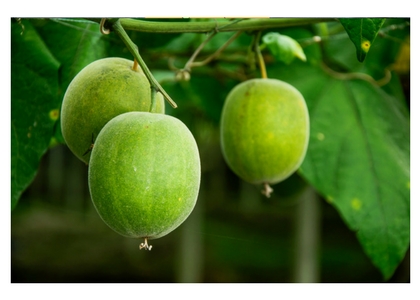
Meet Monk Fruit: A Sweetener from Nature
By Claire Georgiou, Reboot Naturopath, B.HSc ND
Monk fruit, also called the budda fruit or luo han guo, originates from China and was used by monks from the 13th century on. It’s a small tropical melon that can be turned into an extract (like a juice) and dried into a natural sweetener, and is more than 200 times sweeter then cane sugar without the actual sugar or excess calories.
We eat about 82 grams of sugar every single day, which is 5 to 6 times more than the recommended amount.
A diet high in sugar contributes to diabetes, heart disease, obesity, liver disease, poor concentration, fertility problems, eye disease and more. Sugar has been shown to be as addictive as cocaine and alcohol to the reward centers in the brain, and specifically the limbic region. The more sugar you eat it the more you want it.
Excess sugar also effects our satiety and hungry hormones such as insulin and drives us to eat excess food and calories and store fat. Sugar also negatively influences our leptin sensitivity, leptin is a satiety hormone that naturally reduces our appetite. The brain stops hearing, “we are full and satisfied,” causing you to continue to eat beyond a healthy level.
Research has also found that artificial sweeteners have terrible health consequences and have been related to many health problems including obesity and diabetes.
A long history of monk fruit consumption demonstrates it is safe to consume. Health officials in the U.S., Canada, China, Japan, Australia and Singapore have found that monk fruit sweeteners are safe for the general population, including children, people with diabetes, and women who are pregnant or nursing.
Health Benefits
Monk fruit contains an array of antioxidants called mogrosides, which are compounds that offer a sweet taste. These naturally occurring sugars are metabolized differently in the body than sugar and offer a myriad of health benefits, including powerful antioxidants that help fight free radical damage.
Traditionally monk fruit was used to sooth a sore throat and a cough. It’s also been shown to have powerful anti-cancer fighting properties, particularly against breast and skin cancers.
This fruit shows promise for fighting infections and even reducing the incidence of tooth decay. Ironic, right? It also has been shown to reduce fatigue and has anti-diabetic benefits via pancreatic support and improving insulin secretion.
In the Kitchen
Monk fruit is a great addition to your kitchen pantry that offers much of the sweet taste without the bitterness that stevia can have or the chemicals from artificial sweeteners.
It’s an easy substitute that can be used in alternative smart sweets, and easily added to hot or cold drinks, baked goods, salad dressings, sauces, smoothies, frostings, yogurt and other foods that need a little extra sweetness.
When substituting with monk fruit in a recipe, it is important to follow the directions on the packet. It can be a 1:1 ratio while others recommend using half the amount of monk fruit when you are replacing regular sugar in recipes.